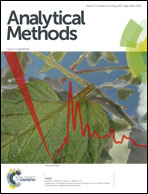An elevated temperature-dispersive liquid–liquid microextraction method combined with GC-flame ionization detection as a sensitive method for determining phthalate esters
Abstract
In the present study, an elevated temperature-dispersive liquid–liquid microextraction method combined with gas chromatography-flame ionization detection has been developed for the extraction, preconcentration and determination of trace concentrations of phthalate esters in aqueous samples. Effects of different variables on the extraction efficiency were studied, in detail. The variables of interest in the proposed method were extraction solvent volume and type, disperser solvent volume and type, temperature, salt effect, pH, extraction time, and centrifugation time and speed. An appropriate mixture of dimethyl sulfoxide (disperser solvent) and 1,2-dibromoethane (extraction solvent) was rapidly injected into a heated aqueous solution of the analytes. Then the heated solution was allowed to cool at room temperature and phase separation was accelerated by centrifuging. Figures of merit such as linearity (r2 > 0.996), enrichment factors (1440–2460), limits of detection (0.25–1.00 ng mL−1) and quantification (0.84–3.64 ng mL−1), extraction recoveries (57–98%), and relative standard deviations (4–8%) for intra-day (n = 6) and inter-day (n = 4) precisions (C = 10 ng mL−1 of each analyte) for the proposed method were satisfactory for determination of the selected phthalate esters.


 Please wait while we load your content...
Please wait while we load your content...